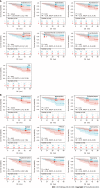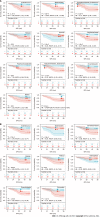Gut mucosal microbiota profiles linked to colorectal cancer recurrence
- PMID: 35664963
- PMCID: PMC9150055
- DOI: 10.3748/wjg.v28.i18.1946
Gut mucosal microbiota profiles linked to colorectal cancer recurrence
Abstract
Background: Emerging evidence links gut microbiota to various human diseases including colorectal cancer (CRC) initiation and development. However, gut microbiota profiles associated with CRC recurrence and patient prognosis are not completely understood yet, especially in a Chinese cohort.
Aim: To investigate the relationship between gut mucosal microbiota profiles and CRC recurrence and patient prognosis.
Methods: We obtained the composition and structure of gut microbiota collected from 75 patients diagnosed with CRC and 26 healthy controls. The patients were followed up by regular examination to determine whether tumors recurred. Triplet-paired samples from on-tumor, adjacent-tumor and off-tumor sites of patients diagnosed with/without CRC recurrence were analyzed to assess spatial-specific patterns of gut mucosal microbiota by 16S ribosomal RNA sequencing. Next, we carried out bioinformatic analyses, Kaplan-Meier survival analyses and Cox regression analyses to determine the relationship between gut mucosal microbiota profiles and CRC recurrence and patient prognosis.
Results: We observed spatial-specific patterns of gut mucosal microbiota profiles linked to CRC recurrence and patient prognosis. A total of 17 bacterial genera/families were identified as potential biomarkers for CRC recurrence and patient prognosis, including Anaerotruncus, Bacteroidales, Coriobacteriaceae, Dialister, Eubacterium, Fusobacterium, Filifactor, Gemella, Haemophilus, Mogibacteriazeae, Pyramidobacter, Parvimonas, Porphyromonadaceae, Slackia, Schwartzia, TG5 and Treponema.
Conclusion: Our work suggests that intestinal microbiota can serve as biomarkers to predict the risk of CRC recurrence and patient death.
Keywords: 16S rRNA sequencing analysis; Biomarker; Colorectal cancer; Colorectal cancer recurrence; Gut microbiota; Prognosis.
©The Author(s) 2022. Published by Baishideng Publishing Group Inc. All rights reserved.
Conflict of interest statement
Conflict-of-interest statement: The authors declare that there is no conflict of interest.
Figures






References
-
- Sung H, Ferlay J, Siegel RL, Laversanne M, Soerjomataram I, Jemal A, Bray F. Global Cancer Statistics 2020: GLOBOCAN Estimates of Incidence and Mortality Worldwide for 36 Cancers in 185 Countries. CA Cancer J Clin. 2021;71:209–249. - PubMed
-
- Dekker E, Tanis PJ, Vleugels JLA, Kasi PM, Wallace MB. Colorectal cancer. Lancet. 2019;394:1467–1480. - PubMed
MeSH terms
Substances
LinkOut - more resources
Full Text Sources
Medical

